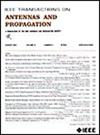利用异质波束元件技术实现二维广角扫描的圆极化相控阵天线
IF 4.6
1区 计算机科学
Q1 ENGINEERING, ELECTRICAL & ELECTRONIC
引用次数: 0
摘要
圆极化(CP)相控阵天线(PAA)在同时实现宽元件波束和轴向比(AR)图案方面经常面临挑战,从而限制了其扫描范围。为解决这一问题,本文在 CP PAA 设计中引入了异质波束元件 (HBE) 技术,提出了实现 HBE 的偏移分段介质透镜 (OSDL) 波束倾斜技术。通过将偏移分段介质透镜定位在元件一侧上方的近场区域内,近场区域被分割成具有不同相位差的多个区段,从而实现元件光束倾斜。研究全面分析了 CP HBE PAA 设计,包括具有宽空间 AR 带宽和高隔离度的 CP 元件设计,以及 OSDL 波束倾斜技术的原理和设计准则。实验结果表明,与 4 元 CP 标准 PAA 相比,扫描范围显著扩大,在 17-20 GHz 波段内,正交平面的扫描范围从 56° 扩大到 75°,对角平面的扫描范围从 58° 扩大到 80°,同时 AR 值保持在 3 dB 以下。OSDL 波束倾斜技术的有效性和稳健性凸显了其作为通用 HBE 实施方法的潜力。本文章由计算机程序翻译,如有差异,请以英文原文为准。
Circularly Polarized Phased Array Antenna With 2-D Wide-Angle Scanning Using Heterogeneous Beam Element Technology
Circularly polarized (CP) phased array antennas (PAAs) often face challenges in achieving wide element beams and axial ratio (AR) patterns simultaneously, thereby constraining their scanning ranges. To address this issue, this article introduces heterogeneous beam element (HBE) technology to the CP PAA design, proposing an offset segmented dielectric lens (OSDLs) beam tilting technology for implementing HBEs. By positioning the OSDL offset within the near-field region above one side of the element, the near-field region is partitioned into multiple segments with varying phase differences, achieving element beam tilting. The study provides a comprehensive analysis of the CP HBE PAA design, encompassing the CP element design with a wide spatial AR bandwidth and high isolation, as well as the principle and design guidelines of the OSDL beam tilting technology. Experimental results demonstrate a significant extension of the scanning range compared to the
$4 \times 4$
-element CP standard PAA, with improvements ranging from 56° to 75° in the orthogonal plane and from 58° to 80° in the diagonal plane across the 17–20-GHz band while maintaining AR values below 3 dB. The effectiveness and robustness of the OSDL beam tilting technology underscore its potential as a universal HBE implementation approach.
求助全文
通过发布文献求助,成功后即可免费获取论文全文。
去求助
来源期刊
CiteScore
10.40
自引率
28.10%
发文量
968
审稿时长
4.7 months
期刊介绍:
IEEE Transactions on Antennas and Propagation includes theoretical and experimental advances in antennas, including design and development, and in the propagation of electromagnetic waves, including scattering, diffraction, and interaction with continuous media; and applications pertaining to antennas and propagation, such as remote sensing, applied optics, and millimeter and submillimeter wave techniques

 求助内容:
求助内容: 应助结果提醒方式:
应助结果提醒方式:


